Of course, motherboards are among the high-quality PC components that Gigabyte is renowned for producing. That they were among the first producers of motherboards for Intel’s 12th Generation Alder Lake processors is therefore not surprising.
The GIGABYTE Aorus series’ entry-level model is the Ultra, which is distinguished from the models with confusing names like Elite, Master, and Pro. The GIGABYTE Z690 AORUS ULTRA Motherboard, which is regarded as one of the more economical entry points into GIGABYTE’s more expensive gaming-focused series, contains many high-end features that support its position as a bridge between the more sophisticated models and its base versions. Regarding the appearance, GIGABYTE chose a contemporary style with a mix of silver and black heatsinks throughout, along with a quirky Aorus logo embroidered onto the top portion of the back panel cover.
Although the AORUS range of motherboards from Gigabyte is recognized as their gaming line, it also has numerous features that enthusiasts would appreciate. The AORUS range for Z690 includes quite a few boards, such as the Pro, Ultra, Elite, Tachyon, Master, and Extreme. It truly depends on which aspects are most important to you because many of these share some similarities. We are looking at the GIGABYTE Z690 AORUS ULTRA Motherboard today, which has four M.2 slots, support for DDR5, USB 3.2 gen 22, a 19-phase power design with 105A power stages, and an improved design from the previous iteration. Do you require this board for your Alder Lake build? Keep reading to find out!
GIGABYTE Z690 AORUS ULTRA Packaging
The standard motherboard retail packaging from Gigabyte contains the GIGABYTE Z690 AORUS ULTRA Motherboard. The board supports DDR5 and PCIe 5.0, which is shown by the huge AORUS logo on the front. The board’s key features are described in full on the rear, along with a list of specifications.

Opening the box reveals six SATA cables, a WiFi antenna, a G-connector, two temperature probes, an RGB extension cable, a microphone, M.2 screws, an installation guide, and a user’s manual in terms of accessories.
GIGABYTE Z690 AORUS ULTRA Motherboard Specs & Performance
One full-length PCIe 5.0 x16 slot is available on the GIGABYTE Z690 AORUS ULTRA Motherboard, but the other two full-length slots are electronically limited to PCIe 3.0 x4 speeds. The Ultra includes four PCIe 4.0 x4 M.2 slots for storage, and its six SATA ports can accommodate RAID 0, 1, 5, and 10 arrays. There are four memory slots with a combined capacity of 128 GB and compatibility for DDR5-6200 in the upper right corner of the device.
One USB 3.2 G2x2 Type-C port, four USB 3.2 G2 Type-A, four USB 3.2 G1 Type-A, and four USB 2.0 ports are all included on the rear panel. A single Intel I225-V 2.5 GbE controller and an Intel AX200 Wi-Fi 6 CNVi are available for networking. Only two 3.5 mm audio ports and a S/PDIF optical output powered by a Realtek ALC4080 HD audio codec are provided for onboard audio by GIGABYTE, but one DisplayPort video output is more practical for customers who want to employ integrated graphics.

The motherboard has a ton of features and is matte black in color. The Full Cover heat shield with Fins-Array II covering the I/O hood, the Mosfets, and VRMs, as well as the M.2 connectors for the SSDs, makes this board heavier than most I’ve seen. The power button, a number of fan and RGB headers, diagnostic LEDs, and other components are all located close to the top of the board. You’ll see a clear CMOS button, a QFlash button, and a ton of headers for additional fans, RGB, USB, and audio toward the bottom.
SPECS
| Socket | LGA1700 |
| Chipset | Z690 |
| Form Factor | ATX |
| Voltage Regulator | 18 Phase (16+2, 105A MOSFETs for Vcore) |
| Video Ports | (1) DisplayPort (v1.4) |
| USB Ports | (1) USB 3.2 Gen 2×2 Type-C port (20 Gbps) (4) USB 3.2 Gen 2 Type-C port (10 Gbps)(4) USB 3.2 Gen 1 (5 Gbps)(4) USB 2.0 (480 Mbps) |
| Network Jacks | (1) 2.5 GbE |
| Audio Jacks | (2) Analog + SPDIF |
| Legacy Ports/Jacks | ✗ |
| PCIe x16 | (1) v. 5.0 (x16)(2) v. 3.0 (x4) |
| CrossFire/SLI | AMD Quad-GPU CrossFire and 2-Way Crossfire |
| DIMM slots | (4) DDR4 6200+(OC), 128GB Capacity |
| M.2 slots | (1) PCIe 4.0 x4 (64 Gbps) / PCIe (up to 110mm)(2) PCIe 4.0 x4 (64 Gbps) / PCIe (up to 110mm)(1) PCIe 4.0 x4 (64 Gbps) / PCIe + SATA (up to 110mm) |
| SATA Ports | (6) SATA3 6 Gbps (Supports RAID 0/1/5/10) |
| USB Headers | (1) USB v3.2 Gen 2×2, Type-C (20 Gbps)(1) USB v3.2 Gen 1 (5 Gbps)(2) USB v2.0 (480 Mbps) |
| Fan/Pump Headers | (8) 4-Pin (CPU, Water cooling CPU, System, System/Pump fans) |
| RGB Headers | (2) aRGB Gen2 (3-pin)(2) RGB (4-pin) |
| Diagnostics Panel | 2-character debug LED, Q-LED |
| Wi-Fi / Bluetooth | Intel AX200 Wi-Fi 6 (2×2 ax, MU-MIMO, 2.4/5/6 GHz, 160 MHz, BT 5.2) |
| Warranty | 3 Years |
Lighting
The only thing that lights up on this board when it comes to lighting is the AORUS logo on the back I/O cover. This is quite subdued for an AORUS board, but keep in mind that if you want to bling up your system even more, there are RGB headers on the board.
Software
With their APP Center, Gigabyte’s motherboard companion software, they greatly simplify the process of downloading apps. You can use it to download all of your motherboard’s drivers, programs, and other accessories. You’ll save so much time doing this!
EasyTune is the primary motherboard auxiliary program from Gigabyte. Within Windows, you may fully adjust your system here. You can choose your operating mode on the main screen.
The Advanced CPU OC tab is the next. You can adjust a variety of CPU tuning settings using the sliders in this area.
Advanced DDR OC gives you the opportunity to modify your timings, memory frequency, and whether or not an XMP profile is enabled. Power settings have to do with advanced power. You have phase control, load line calibrations, and more.
GIGABYTE Z690 AORUS ULTRA Motherboard Tests
We run all of the CPU’s power-saving capabilities with all stock frequencies (including any default boost/turbo) while running our usual benchmarks and power tests. By setting the XMP profile, we set optimized defaults in both the BIOS and the memory. For this baseline testing, the Windows power scheme is set to Balanced (the default), ensuring that the computer idles as it should.

You must be using Windows 11 with its modified scheduler in order to maximize the performance of Intel Alder Lake CPUs. Most of the time, Windows 10 works great. Some tests, such as Cinebench R20, Corona, and POVRay, suffer severe losses. In order to achieve the best performance across the board with Alder Lake, you must upgrade to Windows 11. However, future patches and upgrades could alter that.
Synthetics offer a fantastic tool to assess a board’s performance because equivalent settings ought to yield comparable performance outcomes. However, motherboard manufacturers can still tune for stability or performance in the areas of turbo boost wattage and advanced memory timings, and such settings may affect some testing.
The GIGABYTE Z690 AORUS ULTRA Motherboard performed admirably on average in our synthetic tests, matching but occasionally outperforming several other DDR5 boards we’ve already evaluated. The only results that were slower than average were POV-Ray and the Procyon benchmark.
Beginning with the LAME timed test, the Aorus Ultra performed slower than its DDR5 competitors, more nearly matching the DDR4 boards. The Ultra’s 10.53-second result is over a second slower than the next-slowest DDR5 result. Nevertheless, there isn’t much of a difference between the fastest and slowest DDR5 motherboards in this group of results—only about 2%—so everything is in line with the other datasets.
The results of the corona test were ordinary. In 52 seconds, the Aorus Ultra finished the test and mixed all the results. Using Handbrake, the x264 test took 113 seconds to complete while the x265 test took 302 seconds. Both outcomes are typical.
We’ve updated our game tests as of the Z690 chipset’s release. Far Cry: New Dawn has been updated to Far Cry 6, and F1 2020 has been replaced with F1 2021. The games are played at 1920 x 1080 resolution with the Ultra setting (details listed above). The impact of the CPU tends to decrease as the resolution increases. With these settings, we want to see if there are any performance differences at the most popular resolution with settings that most users use, or at least try to. The majority of the discrepancies between boards in these exams should fall under the margin of error. A minimum frame rate was also added because it can have an impact on your gaming and immersion.
The Z690 Aorus Ultra averaged 165 frames per second (fps) in F1 2021, with lows of 141 fps—pretty close to our current average. The minimum frame rates for Far Cry 6 were 126 frames per second. The minimums are the best outcomes to date, but the majority are only a few frames behind and are therefore undetectable unless you are counting.
Final Thoughts
A reliable performer with lots of amazing features is the GIGABYTE Z690 AORUS ULTRA Motherboard. I enjoy the 16+1+2 direct digital VRM design, along with their SMD design, which is found on the PCIE 5.0 x16 slot, as well as on the reinforced DDR5 slots. I also appreciate the full cover heat shield with Fins Array II.

Your decision essentially comes down to aesthetics and cost. This board costs $349.99(opens in new tab), the same as the ROG Strix Z690-A, however the latter supports slower DDR4 memory (though the cost of entry is cheaper with DDR4). The Z690 Force WIFI from MSI uses DDR5, but it costs more than $25. Gigabyte’s Z690 Aorus Ultra is the best option among these comparably priced options to build your Alder Lake-based system with, provided a fifth M.2 socket or Wi-Fi 6E isn’t necessary.
GIGABYTE Z690 AORUS ULTRA Motherboard
-
Performance - 97%97%
-
Price - 96%96%
-
Value - 97%97%

